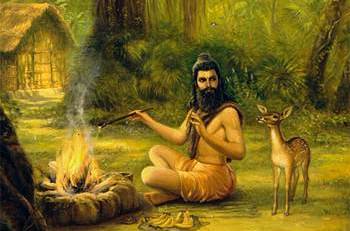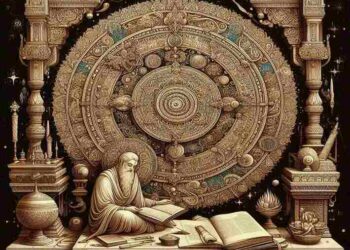Introduction
Bharat Muni’s Natyashastra Summary ,Theme In Detail One of the most significant and fundamental works in the realm of Indian classical arts, especially theater, dance, and music, is Bharata Muni’s Natya Shastra. The theoretical underpinnings and practical features of performing arts in India are described in this ancient text.
This extensive work, which was written between 200 BCE and 200 CE, is frequently referred to as the Bible of Indian theatrical arts. It offers a distinctive perspective on the cultural and artistic context of ancient India by providing thorough explanations of acting, dramatic structure, music, dance, and aesthetics.
Drama, dance (including Bharatanatyam, Kathak, and Odissi), and the theoretical underpinnings of acting and performance have all been significantly impacted by the Natya Shastra. The synopsis, themes, and key ideas of Bharata Muni’s Natya Shastra, as well as its significant influence on Indian creative tradition and ongoing influence on contemporary interpretations of ancient Indian arts, will all be covered in this article.
Summary of Natya Shastra
The Natya Shastra is divided into 36 chapters and 6000 verses (Shlokas), dealing with various aspects of performance. The text itself was said to have been dictated by Brahma, the Hindu god of creation, to Bharata Muni, and it serves as a manual for the performance of Natya (theatre), which includes drama, dance, and music.
1. Origin and Purpose of Natya Shastra
According to the text, Natya was created as a means to convey moral and spiritual lessons, as well as to provide entertainment. It was specifically designed to be performed in front of a gathered audience to stimulate emotions (Rasa), engage with their senses, and communicate ideas.
Bharata Muni presents Natya as a combination of acting, dance, and music, which should be employed in harmony to create a complete artistic experience. The Natya Shastra is not only a guide to the performance of theatre, but also addresses the spiritual, moral, and social functions of theatre.

2. The Four Pillars of Natya Shastra
The Natya Shastra identifies four main elements that form the foundation of dramatic performance:
- Rasa (Emotional Experience): Rasa is the aesthetic flavor or emotional experience that the audience experiences during a performance. It is created through the combination of various Bhavas (emotional states) expressed by the performers, particularly through Abhinaya (acting) and music. Rasa remains the cornerstone of Indian classical theatre.
- Bhava (Emotional State): Bhava refers to the emotional states of the characters, which are evoked in the audience. There are permanent emotional states called Sthayi Bhavas (e.g., love, anger, joy, fear), and transitory emotions called Vyabhichari Bhavas. The emotional depth of the characters is crucial for creating Rasa.
- Abhinaya (Acting and Expression): Abhinaya refers to the expression of emotions, ideas, and feelings through gestures, movements, facial expressions, and speech. There are four types of Abhinaya:
- Angika (Physical Expression): The use of body movements and gestures to convey meaning.
- Vachika (Verbal Expression): The use of words, dialogue, and recitations.
- Aharya (External Expression): The costumes, makeup, and props that enhance the performance.
- Sattvika (Internal Expression): The spontaneous, emotional reactions like trembling, weeping, and perspiration.
- Raga and Tala (Music and Rhythm): Music, rhythm, and dance are considered integral to the performance. The proper use of Raga (melodic structure) and Tala (rhythm) is essential for setting the emotional tone of the play. Music is seen as a medium to enhance the emotional impact of the performance and connect with the audience on a deeper level.
Key Themes of the Natya Shastra
1. The Theory of Rasa
The most influential concept presented in the Natya Shastra is Rasa. Rasa refers to the emotional essence or aesthetic experience that a play evokes in the audience. The goal of any dramatic performance, according to Bharata, is to induce a particular Rasa in the audience through a harmonious combination of Bhavas (emotions of the characters) and Vibhavas (stimuli that evoke emotions).
There are eight primary Rasas:
- Shringara (Love): Romantic love or beauty, associated with feelings of attraction and desire.
- Hasya (Laughter): Joy, humor, or laughter, often leading to merriment and light-heartedness.
- Karuna (Compassion): Sympathy or pity, evoking feelings of sorrow, empathy, and care.
- Raudra (Anger): Wrath, rage, or fury, conveying intense emotions of conflict and struggle.
- Veera (Heroism): Courage or valor, inspiring feelings of bravery, triumph, and honor.
- Bhayanaka (Fear): Fear, terror, or anxiety, evoking feelings of dread and tension.
- Bibhatsa (Disgust): Repulsion or revulsion, associated with feelings of loathing or repugnance.
- Adbhuta (Wonder): Awe, astonishment, or surprise, often evoking feelings of fascination or curiosity.
These Rasas are the fundamental emotional experiences that a drama can evoke, and they can be modified or combined to create complex emotional responses.
2. Dramatic Structure and Composition
The Natya Shastra outlines a five-act structure for a classical play, which is divided into:
- Prakriti (Introduction): Establishes the situation, characters, and setting.
- Riti (Development): Introduces the main conflict, tension, or crisis.
- Sanketa (Climax): The peak of the conflict or the turning point of the story.
- Vidhikriti (Resolution): The resolution of the conflict, where issues are resolved.
- Anukriti (Conclusion): The closing moments that conclude the story and provide closure.
Each act has its own rhythm, pacing, and objectives in driving the plot forward. The structure ensures a balance between emotional development and resolution.
3. Abhinaya (Acting and Expression)
Abhinaya is a critical aspect of the Natya Shastra, and Bharata defines it as the art of conveying emotions and ideas through physical gestures, expressions, and words. Abhinaya helps to communicate the emotions of the characters to the audience, creating a deep emotional connection. It is categorized into:
- Angika (Physical gestures): The movement of the body and limbs, including mudras (hand gestures), Postures, and facial expressions.
- Vachika (Verbal Expression): The use of dialogue, recitations, and vocal tone to convey emotional depth and meaning.
- Aharya (External Expression): The costumes, makeup, and props that enhance the performance and provide additional layers of meaning.
- Sattvika (Internal Expression): The spontaneous, involuntary reactions like trembling, weeping, and perspiration that reflect the inner emotional state of the performer.
4. Raga and Tala in Drama
Bharata emphasized the role of Raga (melody) and Tala (rhythm) in theatre. Raga helps set the emotional mood of the play, while Tala governs the rhythm of both speech and movement, contributing to the pacing and flow of the performance. Music is intertwined with drama, enhancing the emotional impact of the narrative.
Important Concepts in Natya Shastra
1. The Role of the Director (Nayaka)
Bharat Muni’s Natyashastra Summary ,Theme In Detail The director or Nayaka is the central figure responsible for guiding the performance and ensuring that the actors adhere to the principles of the Natya Shastra. The director is expected to have a deep understanding of Rasa, Abhinaya, Bhava, and Tala, and should be able to control the rhythm and tone of the play.
2. The Concept of Sutradhara (Stage Manager)
In classical Indian theatre, the Sutradhara is responsible for the technical and logistical aspects of the performance. The Sutradhara coordinates the movements of the actors, the music, and the rhythm, ensuring that the performance flows smoothly.
3. The Role of Music and Dance
Bharat Muni’s Natyashastra Summary ,Theme In Detail Music and dance are integral parts of the Natya Shastra, and Bharata emphasizes the importance of ragas and talas to enhance the emotional experience.
In classical theatre, music is not just a background element; it is interwoven with the drama to influence the mood, pacing, and emotional impact of the performance. Similarly, dance is used to convey emotions and actions that words cannot fully express.

Conclusion
Bharat Muni’s Natyashastra Summary ,Theme In Detail One of the most significant and extensive pieces of ancient Indian philosophy and art is Bharata Muni’s Natya Shastra. Because it offers a theoretical and practical framework for various creative forms, it has a significant impact on classical Indian dance, music, and theater.
The Natya Shastra provides a thorough grasp of how emotions are expressed in art through the principles of Rasa, Abhinaya, Bhava, and Raga, highlighting the significance of harmony between the aspects of acting, music, and rhythm.
The Natya Shastra explores the intricate relationship between emotion, aesthetics, and performance and serves as both a manual for performing arts and a window into the cultural and spiritual ideals of ancient India. The rich legacy of Indian classical arts is preserved and relevant today because of its guiding ideals, which still serve as an inspiration to contemporary artists and performers.
Read more
FAQ Section
1. What is Rasa in the Natya Shastra?
Rasa refers to the emotional experience or aesthetic flavor that the audience experiences while watching a performance. It is created through the combination of Bhavas (emotions of the characters) and Vibhavas (stimuli that provoke emotions). There are eight primary Rasas: Shringar (Love), Hasya (Laughter), Karuna (Compassion), Raudra (Anger), Veera (Heroism), Bhayanaka (Fear), Bibhatsa (Disgust), and Adbhuta (Wonder).
2. How is Abhinaya related to performance?
Abhinaya refers to the art of acting and expressing emotions through gestures, movements, facial expressions, and dialogue. It is essential for conveying the inner emotions of the character to the audience and is classified into four types: Angika (physical gestures), Vachika (verbal expression), Aharya (external expression like costumes), and Sattvika (internal expressions like spontaneous emotions).
3. What is the importance of Raga and Tala in Natya Shastra?
Raga and Tala are essential in creating the emotional tone of the performance. Raga (melody) sets the mood, while Tala (rhythm) provides structure and pacing to the performance. Both elements work in tandem to enhance the audience’s emotional experience.
4. How does the Natya Shastra influence modern Indian theatre?
The Natya Shastra continues to influence modern Indian theatre by serving as the foundation for acting, dance, and music in classical performances. Elements such as Rasa, Abhinaya, and music are still integral in the creation of traditional performances like Bharatanatyam, Kathak, and Koodiyattam.
















